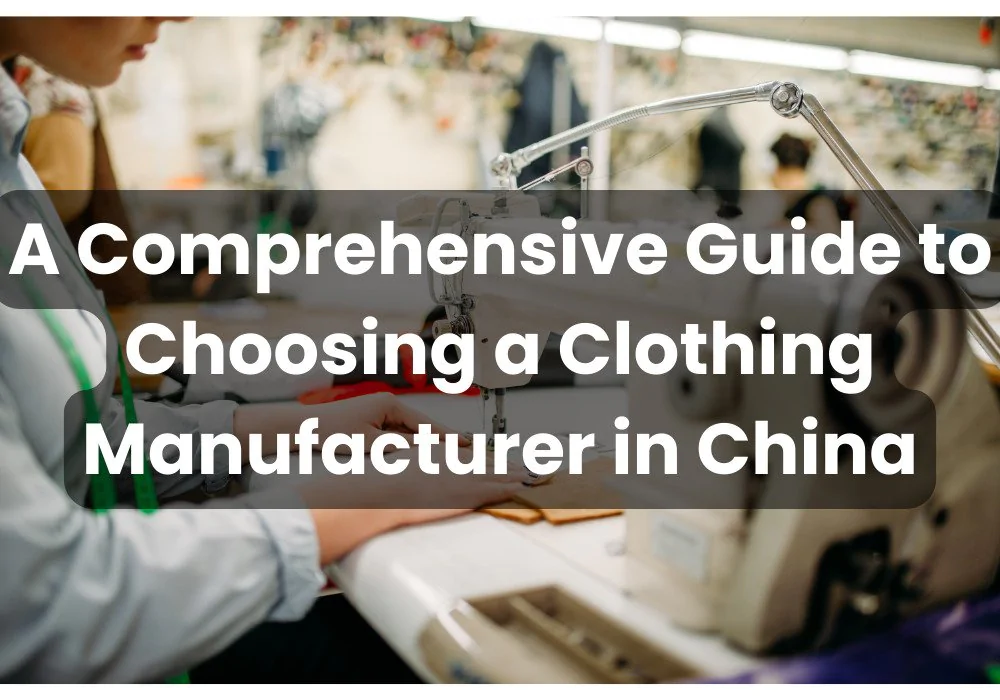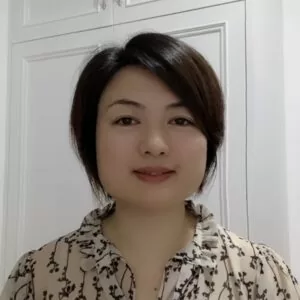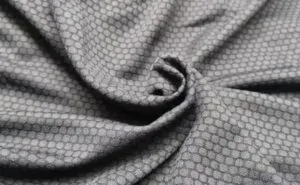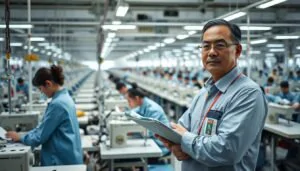Did you know that China is responsible for producing over 30% of the world’s clothing, making it a global hub for apparel manufacturing? As a business owner looking to source clothing, you’re taking a significant step towards tapping into a vast and competitive market. China’s clothing industry has experienced significant growth, driven by its ability to produce high-quality garments at competitive prices.
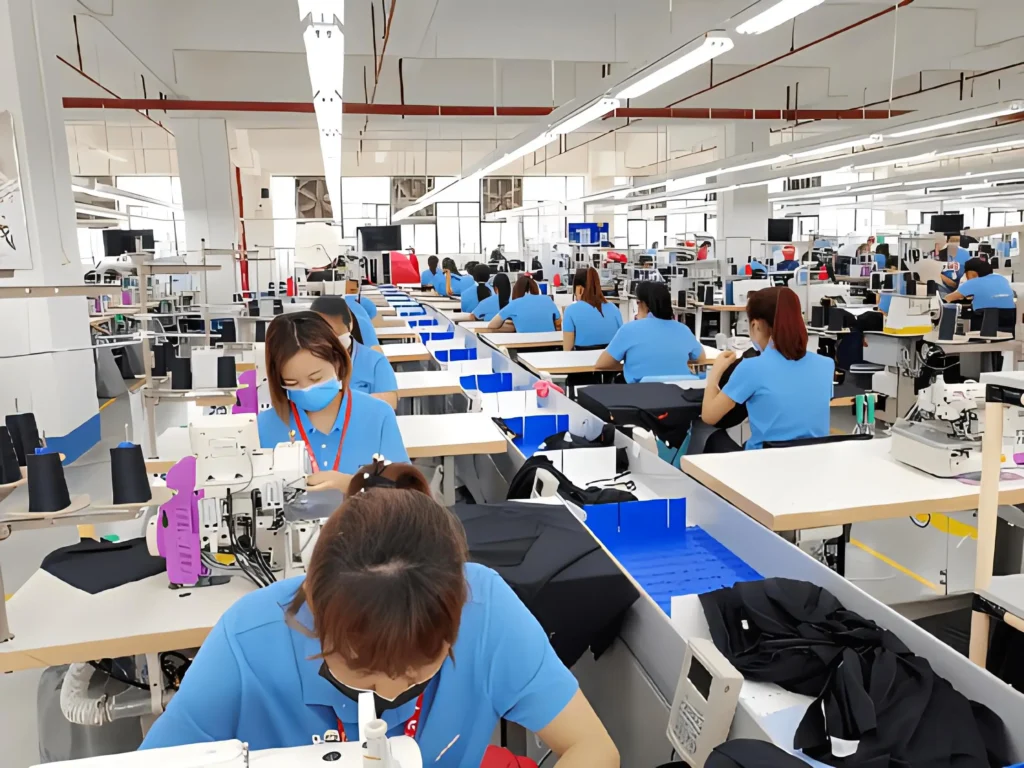
At LoveNaturaltouch, we’ve seen firsthand the benefits of manufacturing in China. With a complete clothing industry chain and mature manufacturing technology, China offers a unique opportunity for businesses to scale their production. In this guide, we’ll walk you through the process of finding a reliable clothing manufacturer in China, covering key aspects such as understanding the Chinese clothing manufacturing landscape and tips for preparing your business for Chinese manufacturing.
Understanding China’s Clothing Manufacturing Landscape
As a global leader in the apparel industry, China’s clothing manufacturing landscape is worth understanding. You are taking a crucial step in identifying the right manufacturing partner by grasping the nuances of China’s clothing production capabilities.
China’s clothing industry is a significant player in the global apparel market, accounting for a substantial portion of worldwide production. The country’s strategic location, vast resources, and investments in technology have cemented its position as a leading manufacturer.
China’s Position in the Global Apparel Industry
China’s dominance in the global apparel industry can be attributed to several factors, including its vast workforce, extensive supply chain network, and government support for the textile and apparel sector. The country’s ability to produce high-quality garments at competitive prices has made it an attractive destination for international brands.
Key Manufacturing Hubs: Guangdong, Zhejiang, and Jiangsu
The Yangtze River Delta and the Pearl River Delta are the heartlands of China’s clothing manufacturing industry. Key provinces such as Guangdong, Zhejiang, and Jiangsu are home to numerous manufacturing facilities, offering a range of production capabilities and specialized services. For instance:
- Guangdong province is known for its fast-fashion production and quick turnaround times.
- Zhejiang province has a strong focus on textile production and fabric innovation.
- Jiangsu province offers a mix of traditional manufacturing and advanced technology integration.
Recent Shifts in Chinese Manufacturing Capabilities
In recent years, China’s clothing manufacturing landscape has undergone significant changes, driven by factors such as rising labor costs, technological advancements, and shifting global trade dynamics. You should be aware of these shifts when evaluating potential manufacturing partners:
Some of the key developments include the adoption of automation and digital technologies, a greater emphasis on sustainability and environmental responsibility, and the emergence of new manufacturing hubs in inland regions.
By understanding these aspects of China’s clothing manufacturing landscape, you can make informed decisions when selecting a manufacturing partner that aligns with your business needs and production requirements.
Benefits and Challenges of Manufacturing in China
China’s clothing manufacturing industry offers numerous advantages, but it also comes with its own set of challenges. As you explore the opportunities and potential pitfalls, understanding the nuances of manufacturing in China is crucial for your business success.
Cost Advantages and Production Capabilities
One of the primary benefits of manufacturing in China is the cost advantage. China’s large-scale manufacturing capabilities and economies of scale enable you to produce high-quality garments at competitive prices. You can leverage China’s vast network of suppliers and manufacturers to find the best deals on materials and labor.
China’s production capabilities are also noteworthy, with many factories equipped to handle large and complex orders. This capability is particularly beneficial for businesses looking to scale their production quickly. By partnering with the right manufacturers, you can ensure timely delivery and maintain a consistent supply chain.
Quality Control and Technical Expertise
While cost is a significant factor, quality control in Chinese manufacturing is equally important. Many Chinese manufacturers have made significant strides in improving their quality control processes, adopting international standards, and implementing rigorous inspection procedures. You can work closely with manufacturers to ensure that your products meet the required standards.
Technical expertise is another area where Chinese manufacturers excel. With advanced technology and skilled labor, you can access a wide range of manufacturing capabilities, from basic apparel production to complex textile manufacturing and printing. This technical expertise allows you to innovate and improve your products continuously.
Navigating Cultural and Communication Barriers
Despite the many advantages, one of the significant challenges of sourcing from China is navigating cultural and communication barriers. Differences in language, business practices, and cultural norms can lead to misunderstandings and delays. To overcome these challenges, it’s essential to establish clear communication channels and build strong relationships with your manufacturing partners.
You can mitigate these risks by working with manufacturers who have experience with international clients and understand the importance of clear communication. Additionally, using sourcing agents or consultants who are familiar with both Chinese and international business practices can help bridge the cultural gap and facilitate smoother transactions.
Preparing Your Business for Chinese Manufacturing

Preparing your business for Chinese manufacturing involves several key steps that can significantly impact your success. To ensure a smooth and successful manufacturing experience in China, you need to be thorough in your preparation.
Developing Detailed Product Specifications
Creating detailed product specifications is the foundation of a successful manufacturing project. You need to provide your manufacturer with clear, precise information about your product, including materials, dimensions, colors, and any specific features or requirements. This step is crucial because it directly affects the quality of the final product and helps avoid costly misunderstandings or rework down the line.
To develop comprehensive specifications, consider the following elements:
- Material specifications: Define the type, quality, and quantity of materials required.
- Design specifications: Include detailed drawings, prototypes, or CAD files.
- Color and finish specifications: Specify exact colors and finishes, using standardized color codes when possible.
- Packaging requirements: Outline how you want your products packaged for shipping.
Setting Realistic Budgets and Production Timelines
Setting realistic budgets and production timelines is vital for managing expectations and ensuring that your manufacturing project stays on track. You need to have a clear understanding of the costs involved in manufacturing your product in China, including material costs, labor, shipping, and any potential tariffs or taxes.
When setting your budget, consider:
- Unit cost: Calculate the cost per unit based on your production volume.
- Tooling costs: Factor in any initial investment required for molds or tooling.
- Shipping and logistics: Include the cost of transporting your goods from the factory to your destination.
For production timelines, you should:
- Understand the manufacturer’s production capacity and lead times.
- Plan for potential delays or issues that may arise during production.
- Establish clear milestones and check-in points with your manufacturer.
Understanding and Negotiating MOQ Requirements
Minimum Order Quantity (MOQ) requirements can significantly impact your business’s cash flow and inventory management. Understanding and negotiating MOQ requirements with your Chinese manufacturer is crucial to ensure that they align with your business needs.
When dealing with MOQ, consider:
- Your sales forecast: Align your MOQ with your expected demand to avoid excess inventory.
- Storage and warehousing capabilities: Assess whether you have the capacity to store larger quantities.
- Negotiation strategies: Be prepared to negotiate MOQs based on your business needs and the manufacturer’s capabilities.
By carefully developing detailed product specifications, setting realistic budgets and production timelines, and understanding MOQ requirements, you can better prepare your business for the challenges and opportunities of Chinese manufacturing.
A Comprehensive Guide to Choosing a Clothing Manufacturer in China
With numerous clothing manufacturers in China, finding the ideal partner demands a strategic approach. You need to consider several factors to ensure that your chosen manufacturer can meet your production needs effectively.
Types of Manufacturers: Trading Companies vs. Direct Factories
When searching for a clothing manufacturer in China, you’ll encounter two primary types: trading companies and direct factories. Understanding the difference between these two is crucial for making an informed decision.
Trading companies act as intermediaries between buyers and manufacturers. They often have established relationships with multiple factories and can offer a range of services, including sourcing, quality control, and logistics management. However, using a trading company may increase your costs and potentially reduce your control over the production process.
Direct factories, on the other hand, are the actual production facilities where your garments will be manufactured. Working directly with a factory can offer cost savings and greater control over production. However, it requires more effort from you to manage the relationship and ensure compliance with your specifications.
Evaluating Technical Capabilities and Specializations
Assessing a manufacturer’s technical capabilities is vital to ensure they can produce the type and quality of clothing you require. Consider the following factors:
- Equipment and technology: Are they using modern machinery and production techniques?
- Production capacity: Can they meet your order quantity and timeline?
- Quality control processes: What measures do they have in place to ensure consistent quality?
- Specializations: Do they have experience with your specific product type or fabric?
Warning Signs and Red Flags in Manufacturer Selection
When evaluating potential manufacturers, be aware of the following warning signs:
- Lack of transparency in their business practices or production processes
- Poor communication or unresponsiveness to your inquiries
- Unrealistic pricing or promises that seem too good to be true
- Negative reviews or feedback from previous clients
By being vigilant and thoroughly researching potential manufacturers, you can avoid common pitfalls and find a reliable partner for your clothing production needs in China.
Effective Methods for Finding Reliable Manufacturers
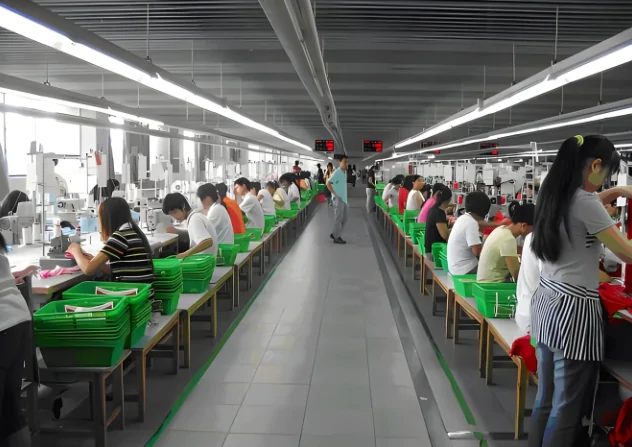
Finding a reliable clothing manufacturer in China is a critical step in ensuring the success of your business. The key to finding a reliable clothing manufacturer in China lies in understanding the most effective methods for sourcing potential partners.
You can employ several strategies to identify trustworthy manufacturers. These methods not only help you find potential partners but also enable you to evaluate their capabilities and reliability.
Leveraging Online Platforms
Online platforms have revolutionized the way businesses connect with manufacturers. You can leverage platforms like Alibaba, Global Sources, and Made-in-China to find and vet potential manufacturers.
- Alibaba: One of the largest B2B marketplaces, offering a vast directory of suppliers.
- Global Sources: A trusted platform that connects buyers with verified suppliers.
- Made-in-China: A comprehensive platform that allows you to directly contact manufacturers.
These platforms provide valuable resources, including supplier directories, product showcases, and customer reviews, helping you make informed decisions.
Attending Trade Shows
Trade shows offer a unique opportunity to meet manufacturers face-to-face, inspect product samples, and assess their production capabilities. Key events include:
- Canton Fair: One of China’s largest and most prestigious trade fairs.
- Textile Expos: Specialized exhibitions focusing on the textile and apparel industry.
Attending these events allows you to network with potential partners, discuss your requirements in detail, and get a firsthand impression of their products and services.
Working with Sourcing Agents and Consultants
Sourcing agents and consultants can provide invaluable assistance in finding and vetting manufacturers. They offer local expertise, language skills, and industry knowledge, helping you navigate the complexities of Chinese manufacturing.
When working with sourcing agents, ensure they have a proven track record, transparent processes, and a strong network of reliable manufacturers.
Vetting and Selecting Your Manufacturing Partner
When it comes to vetting and selecting a manufacturing partner in China, thorough evaluation is key to ensuring a successful partnership. As you’ve identified potential manufacturers, it’s now crucial to assess their capabilities, reliability, and alignment with your business standards.
Critical Questions to Ask Potential Manufacturers
To effectively vet manufacturers, you need to ask the right questions. Consider inquiring about their:
- Production capabilities and capacity
- Quality control processes and certifications
- Material sourcing and supply chain management
- Lead times and shipping logistics
- Compliance with international standards and regulations
As Li & Fung’s former CEO, Bruce Rockowitz, once said,
“The key to success in sourcing is not just about finding the lowest cost, but about building a partnership that can deliver quality, reliability, and flexibility.”
The Sample Development Process
Evaluating a manufacturer’s sample development process is vital. This process typically involves:
- Initial consultation to understand your product requirements
- Prototype development and testing
- Revision and refinement based on your feedback
- Final sample approval before mass production
A robust sample development process ensures that your final products meet your specifications and quality expectations.
Conducting Factory Audits: In-Person vs. Virtual Options
Factory audits are a critical step in vetting manufacturers. You can choose between in-person audits, which provide a firsthand look at the manufacturer’s facilities and practices, or virtual audits, which can be more cost-effective and still offer valuable insights.
During an audit, pay attention to factors such as:
- Facility cleanliness and organization
- Equipment condition and technology level
- Worker training and labor practices
- Quality control measures in place
By thoroughly vetting potential manufacturing partners through critical questioning, sample development evaluation, and factory audits, you can confidently select a reliable partner that meets your business needs.
Negotiating Terms and Protecting Your Business
Negotiating terms with Chinese manufacturers requires a deep understanding of pricing strategies and intellectual property protection. As you navigate this complex process, it’s essential to be well-prepared to ensure that your business interests are safeguarded.
Pricing Strategies and Payment Terms
Understanding pricing strategies is crucial when negotiating with Chinese manufacturers. You need to be aware of the different pricing models, such as cost-plus pricing and market-based pricing, to negotiate effectively. Additionally, payment terms should be clearly defined to avoid any potential disputes. Common payment methods include Letter of Credit (L/C), Telegraphic Transfer (T/T), and PayPal. It’s vital to negotiate payment terms that align with your cash flow requirements.
When discussing pricing, consider factors such as material costs, labor expenses, and production volumes. You should also be aware of any additional costs, such as packaging and shipping expenses. By understanding these elements, you can negotiate a fair price that reflects the true cost of production.
Contracts and Intellectual Property Protection for US Businesses
A well-structured contract is vital when dealing with Chinese manufacturers. It should include provisions for product specifications, production timelines, quality control measures, and payment terms. Moreover, it’s essential to include clauses that protect your intellectual property rights. This can be achieved by registering your trademarks and patents in China and including non-disclosure agreements (NDAs) in your contracts.
To further protect your intellectual property, consider using a non-compete clause and ensuring that your contract specifies the jurisdiction for any potential disputes. It’s also advisable to work with a local attorney who is familiar with Chinese law to review your contracts.
Building Sustainable Relationships with Chinese Partners
Building a sustainable relationship with your Chinese manufacturing partner is key to long-term success. This involves regular communication, mutual respect, and a deep understanding of each other’s needs and expectations. By fostering a positive relationship, you can ensure smoother production processes, better quality control, and more favorable negotiation terms.
To build a strong partnership, consider visiting your manufacturer’s facilities regularly, attending industry events together, and engaging in open dialogue about any issues that arise. By doing so, you can create a collaborative environment that benefits both parties.
Managing Production and Quality Control
When sourcing from China, it’s vital to implement robust production management and quality control processes. Managing production effectively ensures that your products are manufactured according to your specifications, on time, and within budget.
Implementing Effective QC Processes and Inspections
To maintain high-quality standards, you need to implement a comprehensive quality control (QC) process. This involves several steps:
- Pre-production inspection to verify materials and production readiness
- During-production inspection to monitor manufacturing processes
- Final random inspection before shipping to check for defects
Utilizing a third-party inspection service can provide an unbiased assessment of your product’s quality. You can also work closely with your manufacturer to establish a quality control protocol that meets your standards.
Handling Production Delays and Common Issues
Despite careful planning, production delays can occur. Common issues include material shortages, equipment failures, and labor shortages. To mitigate these risks, you should:
- Develop a contingency plan with your manufacturer
- Regularly check production progress
- Maintain open communication channels with your production team
By being proactive, you can address potential issues before they escalate into major problems.
Shipping, Customs, and Import Regulations for US Companies
Once your products are manufactured, you need to navigate the complexities of shipping and customs regulations. For US companies, this involves understanding:
- Harmonized System (HS) codes for product classification
- Customs clearance procedures in both China and the US
- Import duties, taxes, and potential tariffs on clothing imports
Working with a freight forwarder or customs broker can simplify this process and ensure compliance with all relevant regulations.
By effectively managing production, implementing rigorous quality control, and understanding shipping and customs regulations, you can ensure a smooth and successful sourcing experience from China.
Conclusion: Taking the Next Steps in Your Manufacturing Journey
As you navigate the complexities of sourcing from China, you’ve gained a comprehensive understanding of the clothing manufacturing landscape. By following this guide, you’re now equipped to take the next steps in your manufacturing journey, ensuring a successful sourcing experience from China.
To recap, you’ve learned how to prepare your business for Chinese manufacturing, choose the right clothing manufacturer, and manage production and quality control. You can now confidently evaluate potential manufacturers, negotiate terms, and protect your business interests.
As you move forward, consider partnering with a reliable Chinese clothing manufacturer like LoveNaturaltouch, which can help you achieve your sourcing goals and build a long-term partnership. By doing so, you’ll be well on your way to a successful manufacturing journey and can focus on growing your business.

